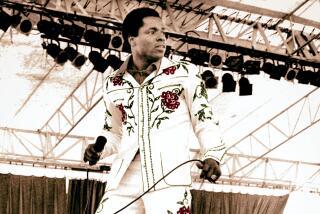In the Mood for All of Glenn Miller?
- Share via
There has been little in musical history comparable to the Glenn Miller mystique. Almost 47 years after his death--he disappeared over the English Channel in December, 1944, while flying to Paris to meet his Army Air Force Orchestra--Miller remains a hero to many.
A band bearing his name, its members born years after he died, still fills concert halls and ballrooms. (The Miller orchestra will appear Saturday at the Long Beach Convention Center and next Sunday at the Citrus College Arts Center in Glendora.)
The original, civilian ensemble had a short life. Its entire output on the old Bluebird label (35 cents in those days) is collected in this 13-CD package ($139, please). To hear each tune through even once takes up about 15 hours, not allowing for another hour or two to read the 140-page booklet.
What was it that established Miller as a pop music giant--the Michael Jackson of his day?
The answer might be found in Miller’s reaction to a negative review by the critic John Hammond. “Why do you judge me as a musician, John?” Miller snapped. “All I’m interested in is making money.” Indeed he was, and he found the perfect formula.
A strict disciplinarian, he ruled his troops like a martinet. Many sidemen disliked him and his music (“the coldest fish that ever lived,” said saxophonist Hal McIntyre), though some respected him (“a brilliant man, an honorable man,” according to cornetist Bobby Hackett).
Much of this personality is reflected in the music. What Miller himself may have lacked as a musician (Benny Goodman called him “a pedestrian trombonist”) he made up for with an uncanny sense of what the young crowd wanted in those innocent times.
He promised listeners a little of everything--and delivered: the pleasing instrumental sound, using clarinet instead of alto sax to lead the reed section on such tunes as his famous theme “Moonlight Serenade”; occasional touches of watered-down jazz, but some of these, like Billy May’s slow-tempo version of “Take the ‘A’ Train” came off exceptionally well; attempts to swing the classics (Ravel, Debussy, Beethoven, Verdi and Tchaikovsky are all represented), and, of course, the pop songs.
Of the staggering 287 tunes in this collection, no fewer than 230 have vocals. Miller usually employed seven singers. All were capable interpreters of songs that ranged from the superior (“Indian Summer,” “Melancholy Lullaby,” the latter composed and arranged by Benny Carter) to mundane.
Miller audiences were fed “Three Little Fishes,” “Booglie Wooglie Piggy” and--who can ever forget?--”Conchita, Marquita, Lolita, Pepita, Rosita, Juanita Lopez” (from the film “Priorities on Parade”), with vocals by Marion Hutton, Tex Beneke and the Modernaires.
Everything Miller recorded was impeccably performed, but some of his own jazz arrangements (“King Porter’s Stomp,” “Bugle Call Rag”) lacked the luster of previous versions by Benny Goodman, Fletcher Henderson and the like.
Though the band was never racially integrated, Miller hired a few talented black writers, most notably Eddie Durham (“Sliphorn Jive,” “Glen Island Special”).
Miller’s biggest instrumental hit, “In the Mood,” was his ingenious extension of a tune by Joe Garland, a saxophonist who had recorded it with Edgar Hayes. Similarly, “Tuxedo Junction,” arranged for Miller by Jerry Gray, was a tune Miller had heard when his band played opposite Erskine Hawkins at the Savoy Ballroom in Harlem.
This collection is hard to assess, since there are one-star cuts alongside others that rate 3 1/2 or four stars. It is doubtful that even nostalgia will induce many tears of joy for “Papa Niccolini (The Happy Cobbler)” or “Ma-ma-Maria (Fee-dle, Ee-dle-lee).”
Yet the vast Glenn Miller legend is by no means built exclusively on trivia. Judicious editing might have reduced this to, say, a four-CD set. That could have made a good case for this orchestra as one that managed at times to set a high standard for the pop-jazz crossover phenomenon it tried so arduously to represent.
** 1/2
GLENN MILLER “The Complete Glenn Miller and His Orchestra (1938-1942)”
RCA Bluebird New albums are rated on a scale of one star (poor) to four (excellent). A rating of five stars is reserved for classic reissues or retrospectives.
More to Read
The biggest entertainment stories
Get our big stories about Hollywood, film, television, music, arts, culture and more right in your inbox as soon as they publish.
You may occasionally receive promotional content from the Los Angeles Times.










